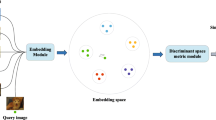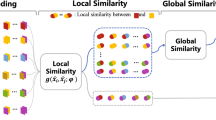Abstract
Few-shot learning aims to make classification when few samples are available. In general, metric-based methods map images into a space by learning the embedding function. However, conventional metric-based methods rely on a single distance value, which does not pay attention to the shallow features. In this paper, we propose a multi-distance metric network (MDM-Net) by employing a multi-output embedding network to map samples into different feature spaces. In addition, we maximize the inter-class distance which is popular in metric learning field to improve the performance of few-shot classifier. Furthermore, we design a task-adaptive margin to adjust the distance between different sample pairs, and we found that the distance loss combined with cross-entropy loss is beneficial to achieve better results in meta-task training. The proposed method is verified by tests on miniImageNet and FC100 these two benchmarks for 5-way 1-shot classification task and 5-way 5-shot classification task with competitive results.









Similar content being viewed by others
References
LeCun Y, Bengio Y, Hinton G (2015) Deep learning. Nature 521(7553):436–444
Krizhevsky A, Sutskever I, Hinton G. (2012) Imagenet classification with deep convolutional neural networks. In: Proceedings of advances in neural information processing systems, pp. 1097–1105
Deng J, Dong W, Socher R, et al. (2009) Imagenet: A large-scale hierarchical image database. In: 2009 IEEE conference on computer vision and pattern recognition, pp. 248–255
Szegedy C, Liu W, Jia Y, et al. (2015) Going deeper with convolutions. In: Proceedings of the IEEE conference on computer vision and pattern recognition, pp. 1–9
Liu W, Anguelov D, Erhan D, et al. (2016) SSD: Single shot multibox detector. In: European conference on computer vision, pp. 21–37
Ren S, He K, Girshick R et al (2015) Faster R-CNN: towards real-time object detection with region proposal networks. IEEE Trans Pattern Anal Mach Intell 39(6):1137–1149
Redmon J, Divvala S, Girshick R, et al. (2016) You only look once: Unified, real-time object detection. In: Proceedings of the IEEE conference on computer vision and pattern recognition, pp. 779–788
He K, Gkioxari G, Dollár P, et al. (2017) Mask R-CNN. In: Proceedings of the IEEE international conference on computer vision, pp. 2961–2969
Kong T, Yao A, Chen Y, et al. (2016) Hypernet: towards accurate region proposal generation and joint object detection. In: Proceedings of the IEEE conference on computer vision and pattern recognition, pp. 845–853
Sang J, Guo P, Xiang Z et al (2017) Vehicle detection based on faster-RCNN. J Chongqing Univ 40(7):32–36
Sharif Razavian A, Azizpour H, Sullivan J, et al. (2014) CNN features off-the-shelf: an astounding baseline for recognition. In: Proceedings of the IEEE conference on computer vision and pattern recognition workshops, pp. 806–813
Hawkins DM (2004) The problem of overfitting. J Chem Inf Comput Sci 44(1):1–12
Srivastava N, Hinton G, Krizhevsky A et al (2014) Dropout: a simple way to prevent neural networks from overfitting. J Mach Learn Res 15(1):1929–1958
Caruana R, Lawrence S, Giles CL. (2001) Overfitting in neural nets: backpropagation, conjugate gradient, and early stopping. In: Advances in neural information processing systems, pp. 402–408
Chawla NV, Bowyer KW, Hall LO et al (2002) SMOTE: synthetic minority over-sampling technique. J Artif Intell Res 16:321–357
Salamon J, Bello JP (2017) Deep convolutional neural networks and data augmentation for environmental sound classification. IEEE Signal Process Lett 24(3):279–283
Cubuk ED, Zoph B, Mane D, et al. (2019) Autoaugment: learning augmentation strategies from data. In: Proceedings of the IEEE conference on computer vision and pattern recognition, pp. 113–123
Socher R, Ganjoo M, Manning CD, et al. (2013) Zero-shot learning through cross-modal transfer. In: Advances in neural information processing systems, pp. 935–943
Ma Y, Cambria E, Gao S (2016) Label embedding for zero-shot fine-grained named entity typing. In: Proceedings of COLING 2016, the 26th International Conference on Computational Linguistics: Technical Papers, pp. 171–180
Jayaraman D, Grauman K (2014) Zero-shot recognition with unreliable attributes. In: Advances in neural information processing systems, pp. 3464–3472
Pan SJ, Yang Q (2009) A survey on transfer learning. IEEE Trans Knowl Data Eng 22(10):1345–1359
Zamir AR, Sax A, Shen W, et al. (2018) Taskonomy: Disentangling task transfer learning. In: Proceedings of the IEEE Conference on computer vision and pattern recognition, pp. 3712–3722
Long M, Zhu H, Wang J, et al. (2016) Unsupervised domain adaptation with residual transfer networks. In: Advances in neural information processing systems, pp. 136–144
Long M, Cao Y, Wang J, et al. (2015) Learning transferable features with deep adaptation networks. In: International conference on machine learning, pp. 97–105
Tzeng E, Hoffman J, Saenko K, et al. (2017) Adversarial discriminative domain adaptation. In: Proceedings of the IEEE conference on computer vision and pattern recognition, pp. 7167–7176
Lake BM, Salakhutdinov RR, Tenenbaum J (2013) One-shot learning by inverting a compositional causal process. In: Advances in neural information processing systems, pp. 2526–2534
Xie R, Liu Z, Jia J, et al. (2016) Representation learning of knowledge graphs with entity descriptions. In: Thirtieth AAAI conference on artificial intelligence, pp. 2659–2665
Triantafillou E, Zemel R, Urtasun R. (2017) Few-shot learning through an information retrieval lens. In: Proceedings of the 31st international conference on neural information processing systems, pp. 2252–2262
Santoro A, Bartunov S, Botvinick M, et al. (2016) Meta-learning with memory-augmented neural networks. In: International conference on machine learning, pp. 1842–1850
Ravi S, Larochelle H. (2017) Optimization as a model for few-shot learning. In: Proceedings of the 5th international conference on learning representations. Toulon, France: ICLR, pp. 4077–4087
Oreshkin B, López PR, Lacoste A. (2018) Tadam: Task dependent adaptive metric for improved few-shot learning. In: Advances in neural information processing systems, pp. 721–731
Cheng G, Zhou P, Han J (2017) Duplex metric learning for image set classification. IEEE Trans Image Process 27(1):281–292
Zhang H, Berg AC, Maire M, et al. (2006) SVM-KNN: Discriminative nearest neighbor classification for visual category recognition. In: 2006 IEEE computer society conference on computer vision and pattern recognition, pp. 2126–2136
Liu X, Zhou F, Liu J et al (2020) Meta-Learning based prototype-relation network for few-shot classification. Neurocomputing 383:224–234
Vinyals O, Blundell C, Lillicrap T, et al. (2016) Matching networks for one shot learning. In: Proceedings of advances in neural information processing systems, pp. 3630–3638
Schroff F, Kalenichenko D, Philbin J (2015) FaceNet: a unified embedding for face recognition and clustering. In: Computer vision and pattern recognition, pp. 815–823
Oreshkin BN, Lopez PR, Lacoste A. (2018) TADAM: task dependent adaptive metric for improved few-shot learning. In: Neural information processing systems, pp. 721–731
Koch G, Zemel R, Salakhutdinov R (2015) Siamese neural networks for one-shot image recognition. In: ICML deep learning workshop, pp. 1–2
Snell J, Swersky K, Zemel R (2017) Prototypical networks for few-shot learning. In: Proceedings of advances in neural information processing systems. pp. 4077–4087
Li W, Wang L, Xu J, et al. (2019) Revisiting local descriptor based image-to-class measure for few-shot learning. In: Computer vision and pattern recognition, pp. 7260–7268
Li W, Wang L, Huo J, et al. (2020) Asymmetric distribution measure for few-shot learning. In: Proceedings of the twenty-ninth international joint conference on artificial intelligence, pp. 2957–2963
Chen H, Li H, Li Y, et al. (2021) Multi-level Metric Learning for Few-shot Image Recognition. arXiv:2103.11383; https://arxiv.org/abs/2103.11383v11383
Wang Y, Chao W, Weinberger KQ, et al. (2019) SimpleShot: Revisiting nearest-neighbor classification for few-shot learning. arXiv:1911.04623. https://arxiv.org/abs/1911.04623
Berthelot D, Carlini N, Goodfellow I, et al. (2019) MixMatch: a holistic approach to semi-supervised learning. In: neural information processing systems, pp. 5049–5059
Krizhevsky A, Nair V, Hinton G (2009) Cifar-10 and cifar-100 datasets. URl: https://www.cs.toronto.edu/kriz/cifar.html:
Munkhdalai T, Yu H (2017) Meta networks. In: Proceedings of the 34th international conference on machine learning, pp. 2554–2563
Finn C, Abbeel P, Levine S. (2017) Model-agnostic meta-learning for fast adaptation of deep networks. In: Proceedings of the 34th international conference on machine learning, pp. 1126–1135
Finn C, Xu K, Levine S. (2018) Probabilistic model-agnostic meta-learning. In: Neural information processing systems, pp. 9516–9527
Satorras VG, Estrach JB (2018) Few-shot learning with graph neural networks. In: 6th international conference on learning representations, pp. 1–13
Sung F, Yang Y, Zhang L, et al. (2018) Learning to compare: relation network for few-shot learning. In: Proceedings of the IEEE conference on computer vision and pattern recognition, pp. 1199–1208
Lee Y, Choi S. (2018) Gradient-based meta-learning with learned layerwise metric and subspace. In: International conference on machine learning, pp. 2927–2936
Mishra N, Rohaninejad M, Chen X, et al. (2018) A simple neural attentive meta-learner. In: 6th international conference on learning representations, pp. 1–17
Munkhdalai T, Yuan X, Mehri S, et al. (2018) Rapid adaptation with conditionally shifted neurons. In: International conference on machine learning, pp. 3661–3670
Liu Y, Lee J, Park M, et al. (2019) Learning to propagate labels: Transductive propagation network for few-shot learning. In: 7th international conference on learning representations, pp. 1–11
Sun Q, Liu Y, Chua T, et al. (2019) Meta-transfer learning for few-shot learning. In: Computer vision and pattern recognition, pp. 403–412
Chen W, Liu Y, Kira Z, et al. (2019) A closer look at few-shot classification. In: 7th international conference on learning representations., pp. 1–17
Lee K, Maji S, Ravichandran A, et al. (2019) Meta-learning with differentiable convex optimization. In: Computer vision and pattern recognition, pp. 10657–10665
Lifchitz Y, Avrithis Y, Picard S, et al. (2019) Dense classification and implanting for few-shot learning. In: Computer vision and pattern recognition, pp. 9258–9267
Acknowledgements
This work was supported by the National Key Research and Development Program of China (2018AAA0101601), and the Zhejiang Provincial Natural Science Foundation of China (LY20E050011).
Author information
Authors and Affiliations
Corresponding author
Additional information
Publisher's Note
Springer Nature remains neutral with regard to jurisdictional claims in published maps and institutional affiliations.
Rights and permissions
About this article
Cite this article
Gao, F., Cai, L., Yang, Z. et al. Multi-distance metric network for few-shot learning. Int. J. Mach. Learn. & Cyber. 13, 2495–2506 (2022). https://doi.org/10.1007/s13042-022-01539-1
Received:
Accepted:
Published:
Issue Date:
DOI: https://doi.org/10.1007/s13042-022-01539-1




